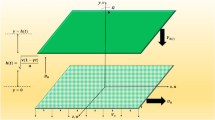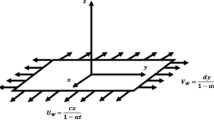Abstract
The present numerical study deals with the analysis of hydrodynamic and thermal characteristics of a shear-thinning Herschel–Bulkley fluid flow within a pipe of a circular cross section, maintained at a uniform wall temperature. The governing equations of the studied steady problem are solved using a homemade computer code based on the finite volume method. The paper is focused on the consequences of neglecting the temperature dependency of the fluid’s consistency and/or the viscous dissipation on both pressure drop and heat transfer. The results show, indeed, that neglecting the temperature dependency of the fluid’s viscosity leads to significantly undervalue these parameters, especially when viscous dissipation is also missed. Abacuses depicting the friction factor of Fanning and the Nusselt number variations according to both Brinkman number and dimensionless temperature coefficient are proposed to sum up the study.














Similar content being viewed by others
Abbreviations
- a :
-
Temperature coefficient (K−1)
- \(a^{*}\) :
-
Dimensionless temperature coefficient, = a ΔT
- Br :
-
Brinkman number, \({{K_{0} V_{0}^{2} } \mathord{\left/ {\vphantom {{K_{0} V_{0}^{2} } {k(T_{0} - T_{\text{w}} )}}} \right. \kern-0pt} {k(T_{0} - T_{\text{w}} )}}\)
- C p :
-
Specific heat at constant pressure (J kg−1 K−1)
- D :
-
Pipe diameter (m)
- f :
-
Friction factor
- f Re :
-
Friction factor of Fanning
- h :
-
Heat transfer coefficient (W m−2 K−1)
- HB :
-
Herschel–Bulkley number, \({{\tau_{0} D^{n} } \mathord{\left/ {\vphantom {{\tau_{0} D^{n} } {K_{0} V_{0}^{n} }}} \right. \kern-0pt} {K_{0} V_{0}^{n} }}\)
- k :
-
Fluid thermal conductivity (W m−1 K−1)
- K :
-
Fluid consistency (Pa sn)
- K 0 :
-
Fluid consistency at the reference temperature (Pa sn)
- \(K^{*}\) :
-
Dimensionless fluid consistency, K(T)/K 0
- L :
-
Pipe length (m)
- m :
-
Exponential growth parameter (s)
- M :
-
Dimensionless exponential growth parameter in Eq. (6), = m V 0/D
- n :
-
Flow index
- Na :
-
Nahme number, \(= {{a\,K_{0} V_{0}^{2} } \mathord{\left/ {\vphantom {{a\,K_{0} V_{0}^{2} } k}} \right. \kern-0pt} k}\)
- Nu :
-
Nusselt number, \(= \frac{hD}{k} = \frac{ - 1}{{\theta_{m} }}\left. {\frac{\partial \theta }{\partial R}} \right|_{R = 0.5}\)
- Pe :
-
Peclet number, = Re Pr
- Pr :
-
Prandtl number, \(= {{K_{0} C_{\text{p}} V_{0}^{n - 1} } \mathord{\left/ {\vphantom {{K_{0} C_{\text{p}} V_{0}^{n - 1} } {kD^{n - 1} }}} \right. \kern-0pt} {kD^{n - 1} }}\)
- \(P^{*}\) :
-
Dimensionless pressure, = \(p^{*}\)/ρ V 20
- \(p^{*}\) :
-
Pressure (Pa)
- r :
-
Radial coordinate (m)
- r p :
-
Plug size (m)
- \(r_{0}^{*}\) :
-
Dimensionless plug size according to [19]
- \(r_{0}^{{\prime }}\) :
-
Dimensionless plug size, r p/(D/2) = τ 0/τ w = \(r_{0}^{*} /2\)
- R :
-
Dimensionless radial coordinate, = r/D
- Re :
-
Reynolds number, \({{ = \rho V_{0}^{2 - n} D^{n} } \mathord{\left/ {\vphantom {{ = \rho V_{0}^{2 - n} D^{n} } {K_{0} }}} \right. \kern-0pt} {K_{0} }}\)
- T :
-
Temperature (K)
- T 0 :
-
Inlet temperature (K)
- T m :
-
Bulk temperature (K)
- T w :
-
Wall temperature (K)
- U :
-
Dimensionless x-component velocity, = Vx/V0
- V :
-
Dimensionless r-component velocity, = V r/V 0
- V 0 :
-
Mean velocity (m s−1)
- V x :
-
x-Component velocity (m s−1)
- V r :
-
r-Component velocity (m s−1)
- x :
-
Axial coordinate (m)
- X :
-
Dimensionless axial coordinate, = x/D
- \(\dot{\gamma }\) :
-
Rate of strain (s−1)
- \(\dot{\gamma }^{*}\) :
-
Dimensionless rate of strain
- ΔT :
-
Temperature difference, = T w − T 0 (K)
- Δp :
-
Pressure drop (Pa)
- η :
-
Effective viscosity of the Herschel–Bulkley fluid (Pa sn)
- η eff :
-
Dimensionless effective viscosity, = η/K 0
- θ :
-
Dimensionless temperature, = (T − T w)/(T 0 − T w)
- θ m :
-
Dimensionless mean temperature, (T m − T w)/(T 0 − T w)
- ρ :
-
Density of the fluid (kg m−3)
- τ :
-
Shear stress (Pa)
- τ 0 :
-
Yield stress (Pa)
- τ w :
-
Wall shear stress (Pa)
- asy:
-
Asymptotic
- av:
-
Average
- c:
-
Centreline
- x:
-
Local
References
Hammad KJ, Vradis GC (1996) Viscous dissipation and heat transfer in pulsatile flows of a yield stress fluid. Int Commun Heat Mass Transf 23–5:599–612
Vradis GC, Dougher J, Kumar S (1993) Entrance pipe flow and heat transfer for a Bingham plastic. Int J Heat Mass Transf 36–3:543–552
Min T, Choi HG, Yoo JY, Choi H (1997) Laminar convective heat transfer of a Bingham plastic in a circular pipe II. Numerical approach hydrodynamically developing flow and simultaneously developing flow. Int J Heat Mass Transf 40–15:3689–3701
Nascimento UCS, Macêdo EN, Quaresma JNN (2002) Thermal entry region analysis through the finite integral transform technique in laminar flow of Bingham fluids within concentric annular ducts. Int J Heat Mass Transf 45:923–929
Soares EJ, Naccache MF, Souza Mendes PR (2003) Heat transfer to viscoplastic materials flowing axially through concentric annuli. Int J Heat Fluid Flow 24:762–773
Khatyr R, Ouldhadda D, Il Idrissi A (2002) Approche analytique de la convection forcée des fluides de Bingham dans un tube. C R Méc 330:69–75
Khatyr R, Ouldhadda D, Il Idrissi A (2003) Viscous dissipation effects on the asymptotic behaviour of laminar forced convection for Bingham plastics in circular ducts. Int J Heat Mass Transf 46:589–598
Piau JM (2007) Carbopol gels: elastoviscoplastic and slippery glasses made of individual swollen sponges Meso- and macroscopic properties, constitutive equations and scaling laws. J Nonnewton Fluid Mech 144:1–29
Duvaut G, Lions JL (1972) Transfert de chaleur dans un fluide de Bingham dont la viscosité dépend de la température. J Funct Anal 11:93–110
Vinay G, Wachs A, Agassant JF (2005) Numerical simulation of non-isothermal viscoplastic waxy crude oil flows. J Nonnewton Fluid Mech 128:144–162
Soares M, Naccache MF, Souza Mendes PR (1999) Heat transfer to viscoplastic materials flowing laminarly in the entrance region of tubes. Int J Heat Fluid Flow 20:60–67
Nouar C (2005) Thermal convection for a thermo-dependent yield stress fluid in an axisymmetric horizontal duct. Int J Heat Mass Transf 48:5520–5535
Peixinho J, Desaubry C, Lebouche M (2008) Heat transfer of a non-Newtonian fluid (Carbopol aqueous solution) in transitional pipe flow. Int J Heat Mass Transf 51:198–209
Labsi N, Benkahla YK, Boutra A, Ammouri A (2013) Heat and flow properties of a temperature dependent viscoplastic fluid including viscous dissipation. J Food Process Eng 36:450–461
Mitsoulis E (2004) On creeping drag flow of a viscoplastic fluid past a circular cylinder: wall effects. Chem Eng Sci 59:789–800
Papanastasiou TC (1987) Flow of materials with yield. J Rheol 31:385–404
Mitsoulis E, Galazoulas S (2009) Simulation of viscoplastic flow past cylinders in tubes. J Nonnewton Fluid Mech 158:132–141
Patankar SV (1980) Numerical heat transfer and fluid flow. Hemisphere Publishing Co., New York
Peixinho J, Nouar C, Desaubry C, Théron B (2005) Laminar transitional and turbulent flow of yield stress fluid in a pipe. J Nonnewton Fluid Mech 128:172–184
Jambal O, Shigechi T, Davaa G, Momoki S (2005) Effects of viscous dissipation and fluid axial heat conduction on heat transfer for non-Newtonian fluids in ducts with uniform wall temperature, part I: parallel plates and circular ducts. Int Commun Heat Mass Transf 32:1165–1173
Quaresma JNN, Macêdo EN (1998) Integral transform solution for the forced convection of Herschel–Bulkley fluids in circular tubes and parallel-plates ducts. Braz J Chem Eng. doi:10.1590/S0104-66321998000100008
Nouar C, Devienne R, Lebouché M (1994) Convection thermique pour un fluide de Herschel–Bulkley dans la région d’entrée d’une conduite. Int J Heat Mass Transf 37–1:1–12
Métivier C, Nouar C (2009) Linear stability of the Rayleigh–Bénard Poiseuille flow for thermodependent viscoplastic fluids. J Nonnewton Fluid Mech 163:1–8
Winter HH (1977) Viscous dissipation in shear flows of molten polymers. Adv Heat Transf 13:205–267
Mitsoulis E, Abdali SS, Markatos NC (1993) Flow simulation of Herschel–Bulkley fluids through extrusion dies. Can J Chem Eng 71:147–160
Aydin O (2005) Effects of viscous dissipation on the heat transfer in forced pipe flow. Part 1: both hydrodynamically and thermally fully developed flow. Energy Convers Manag 46:757–769
Author information
Authors and Affiliations
Corresponding author
Additional information
Technical Editor: Roney Leon Thompson.
Rights and permissions
About this article
Cite this article
Labsi, N., Benkahla, Y.K. & Boutra, A. Temperature-dependent shear-thinning Herschel–Bulkley fluid flow by taking into account viscous dissipation. J Braz. Soc. Mech. Sci. Eng. 39, 267–277 (2017). https://doi.org/10.1007/s40430-016-0499-5
Received:
Accepted:
Published:
Issue Date:
DOI: https://doi.org/10.1007/s40430-016-0499-5




